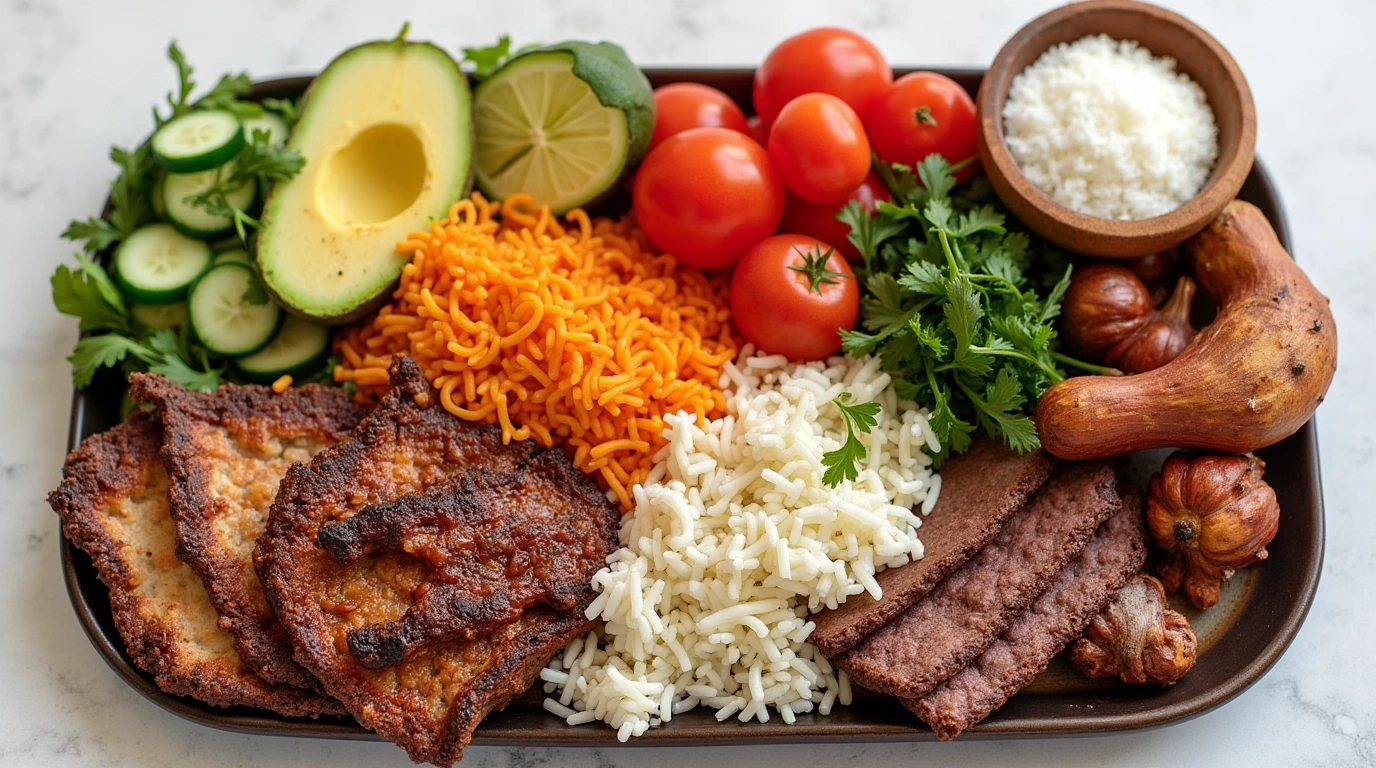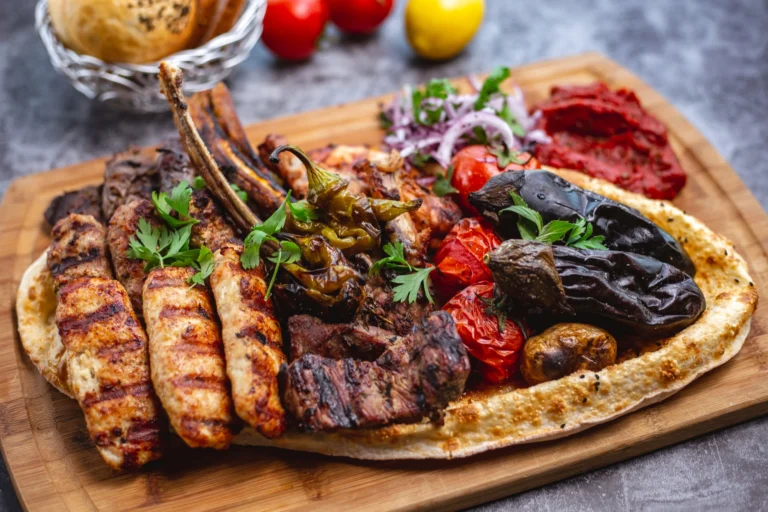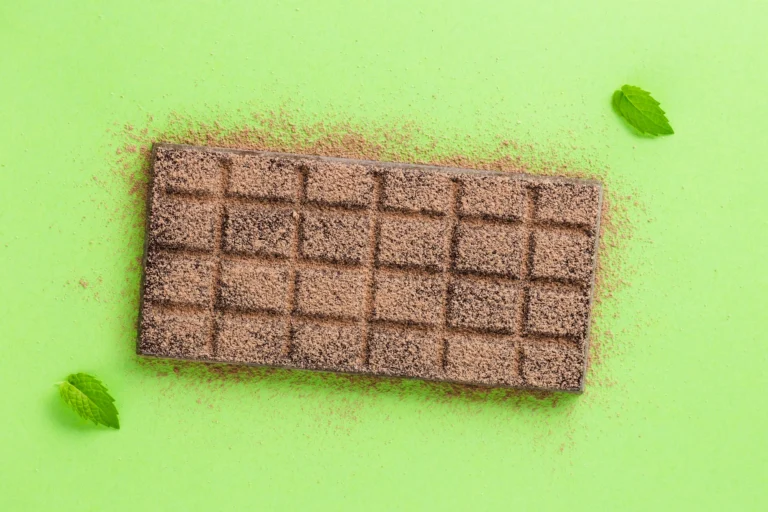10 Best Colombian Foods That Will Transform Your Culinary Adventure
Picture yourself wandering through the vibrant streets of Bogotá, where the aroma of freshly made arepas mingles with the sweet scent of tropical fruits. Colombian foods are more than just sustenance – they’re a gateway to understanding the heart and soul of this diverse nation. As someone who’s spent countless hours exploring the culinary landscape of Colombia, I’m excited to take you on a journey through the country’s most beloved dishes.
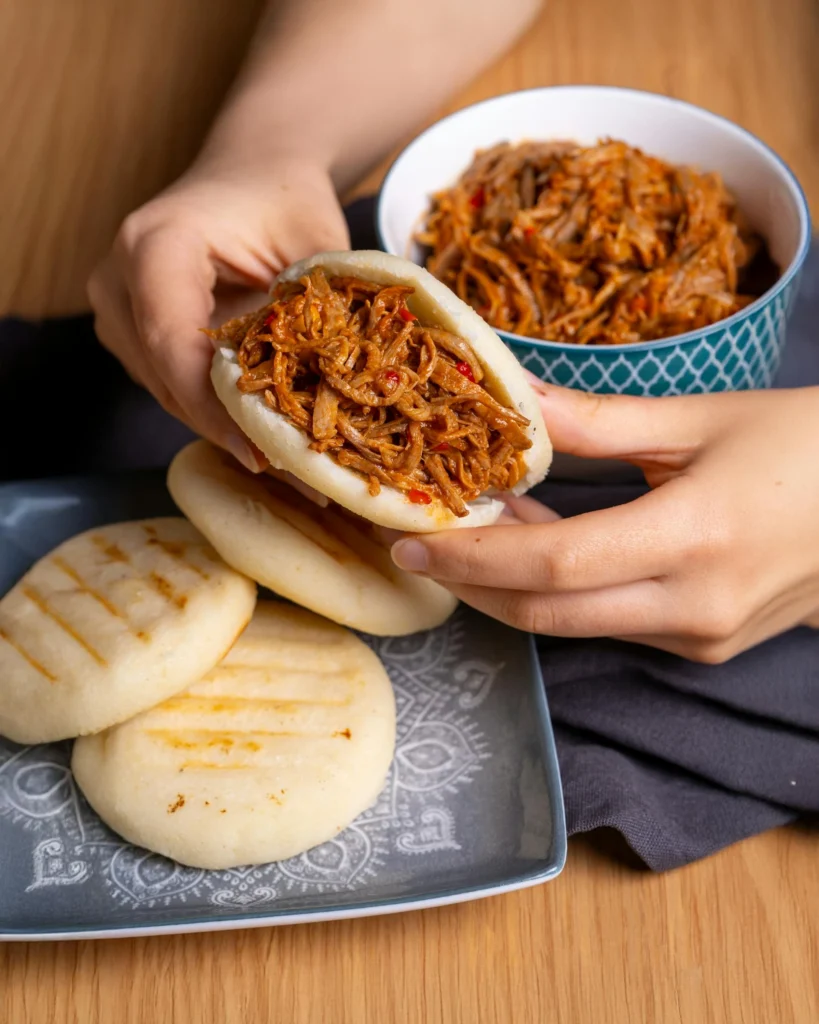
The Rich Tapestry of Colombian Cuisine
Colombian cuisine is a fascinating blend of indigenous traditions, Spanish influences, and African heritage. What makes Colombian foods truly special is how they vary from region to region, each area boasting its own unique specialties and cooking methods. From the hearty dishes of the Andean highlands to the fresh seafood of the coastal regions, Colombian traditional food tells the story of its people and their connection to the land.
Top 10 Must-Try Colombian Dishes
1. Bandeja Paisa – The Crown Jewel
The undisputed king of Colombian dishes, Bandeja Paisa is a feast fit for a hungry traveler. This hearty platter originated in the Antioquia region and represents the epitome of Colombian food culture. Picture this: a generous portion of red beans cooked with pork, white rice, ground beef, chicharrón (crispy pork belly), fried egg, plantains, avocado, and arepa. It’s typically served with a side of hogao sauce – a traditional Colombian tomato and onion sauce that adds an extra layer of flavor.
2. Arepas – The Daily Bread
No discussion about food of Colombia would be complete without mentioning arepas. These cornmeal patties are to Colombians what bread is to Europeans – a daily essential. What fascinates me most about arepas is their versatility. You can find them:
- Plain and simple, perfect for breakfast
- Stuffed with cheese (arepa de queso)
- Topped with eggs (arepa con huevo)
- Filled with meat and vegetables
3. Ajiaco – Soul-Warming Soup
One of the favorite foods of Colombians, especially in Bogotá, is Ajiaco. This hearty soup combines three types of potatoes, shredded chicken, corn, and herbs like guascas, which gives it its distinctive flavor. It’s traditionally served with cream, capers, and avocado on the side. During my first winter in Bogotá, this soup became my go-to comfort food.
4. Empanadas Colombianas
While many Latin American countries have their version of empanadas, Colombian empanadas stand out with their corn-based dough and unique filling combinations. These golden-fried pockets are typically stuffed with meat, potatoes, and rice, served with ají (Colombian hot sauce) on the side.
5. Lechona – The Feast Maker
This dishes from Colombia is a true showstopper at any celebration. A whole pig is stuffed with rice, peas, and spices, then slow-roasted until the skin is crispy and the meat is tender. The combination of crispy skin (cuero) and flavorful rice makes it an unforgettable experience.
6. Sancocho – The Family Gathering Dish
This hearty soup varies by region but typically includes various meats, plantains, yuca, corn, and potatoes. What makes Colombian traditional food like sancocho special is how it brings families together, especially on weekends.
7. Cazuela de Mariscos
Representing the coastal regions, this seafood stew is rich, creamy, and packed with various seafood including shrimp, fish, and shellfish. It’s typically served with coconut rice and patacones (fried plantains).
8. Fritanga
A popular street food and party dish, fritanga is a platter of various fried meats including chicharrón, morcilla (blood sausage), chorizo, and fried organs, served with arepas and plantains.
9. Patacones
These twice-fried plantain slices are a staple side dish in Colombian foods. They’re crispy on the outside, tender inside, and often served with hogao sauce or guacamole.
10. Tamales Colombianos
Colombian tamales differ from their Mexican cousins, wrapped in banana leaves and filled with a mixture of rice, meat, chickpeas, and vegetables. Each region has its own variation, making it one of the most diverse Colombian dishes.
Colombian Street Food Culture
One cannot truly experience Colombian foods without diving into the vibrant street food scene. From busy corners in Medellín to the bustling markets of Cartagena, street vendors offer a taste of authentic Colombian cuisine at its most accessible.
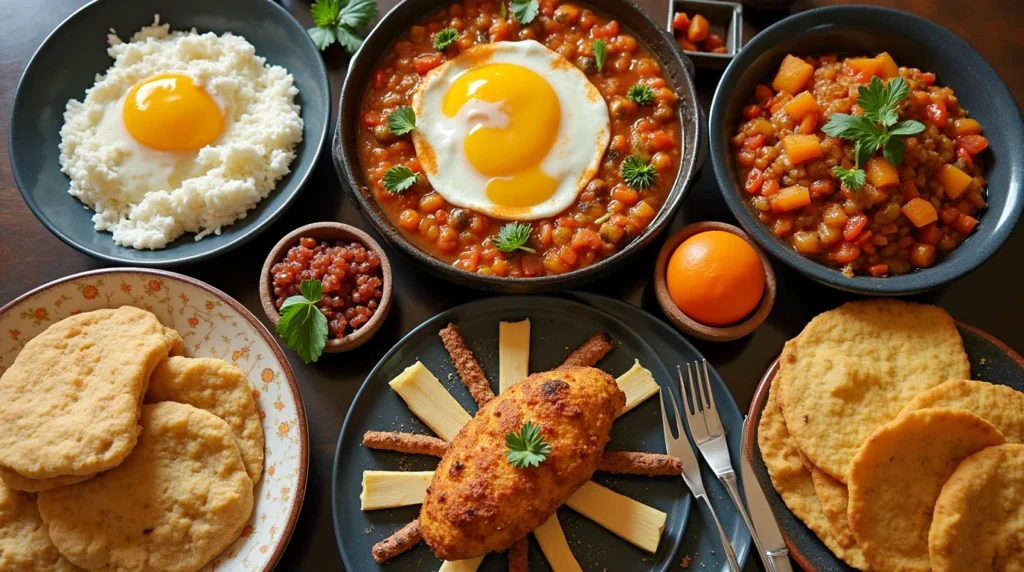
Regional Specialties Across Colombia
The beauty of Colombian traditional food lies in its regional diversity:
- Caribbean Coast: Fresh seafood and coconut-based dishes
- Andean Region: Hearty soups and meat dishes
- Pacific Coast: Unique seafood preparations with African influences
- Amazon Region: Exotic fruits and freshwater fish
- Eastern Plains: Meat-heavy dishes and unique cooking methods
Essential Ingredients in Colombian Cooking
Understanding Colombian dishes requires familiarity with key ingredients:
- Corn: Used in arepas, empanadas, and mazamorra
- Plantains: Both green and ripe varieties
- Yuca: A versatile root vegetable
- Potatoes: Various types used in different dishes
- Beans: Essential in many traditional preparations
- Rice: A staple in Colombian cuisine
- Tropical Fruits: Used in drinks, desserts, and snacks
The Art of Colombian Beverages
No exploration of Colombian foods would be complete without mentioning the incredible variety of beverages that accompany these dishes. From morning pick-me-ups to evening refreshments, Colombian drinks are as diverse as their cuisine.
Coffee Culture
Colombia’s reputation for producing some of the world’s finest coffee is well-deserved. The traditional “tinto” (black coffee) is more than just a beverage – it’s a social custom. In many Colombian dishes, coffee plays a role not just as a drink but as an ingredient in desserts and sauces.
Fruit Juices (Jugos Naturales)
The abundance of tropical fruits in Colombia leads to an impressive variety of fresh juices. Some must-try options include:
- Lulo: A citrusy fruit unique to the region
- Maracuyá (Passion Fruit): Tart and refreshing
- Guanábana (Soursop): Creamy and sweet
- Mora (Blackberry): Popular in the Andean region
- Tomate de Árbol (Tree Tomato): A unique flavor profile
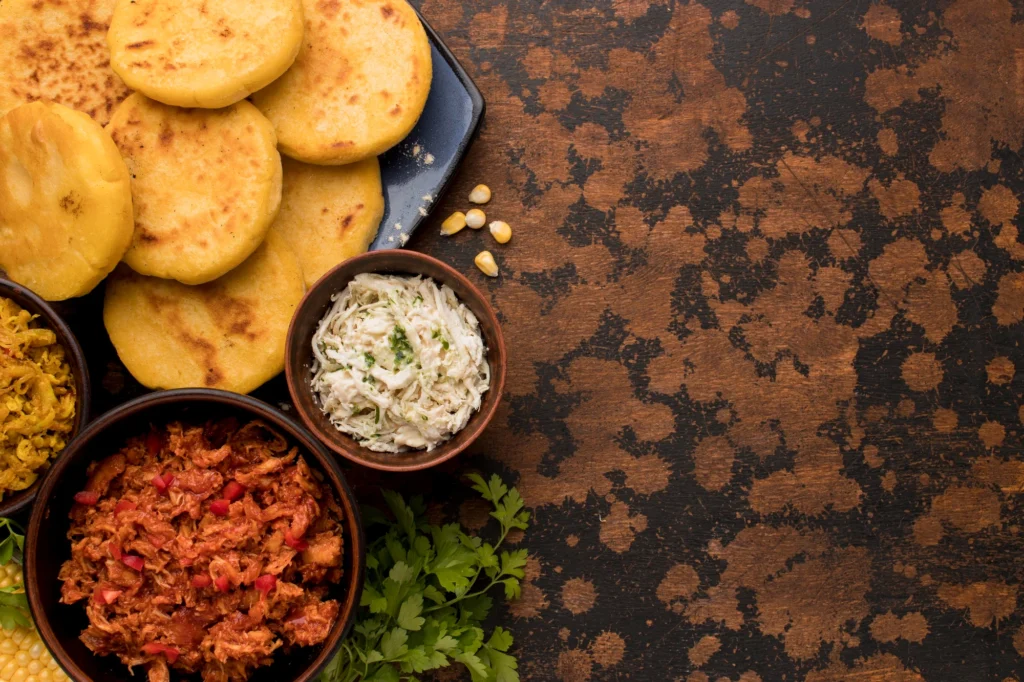
Traditional Colombian Drinks
- Aguardiente: The national spirit of Colombia
- Refajo: A mixture of Colombian beer and Colombiana (local soda)
- Chocolate Santafereño: Hot chocolate served with cheese
- Chicha: A fermented corn beverage with indigenous roots
Vegetarian Options in Colombian Cuisine
While Colombian traditional food is often meat-centric, there are numerous delicious vegetarian options:
Vegetarian Main Dishes
- Frijoles Rojos (Red Beans)
- Traditionally prepared with vegetables and spices
- Served with rice, plantains, and avocado
- Arroz con Coco (Coconut Rice)
- A coastal specialty
- Perfect accompaniment to vegetable dishes
- Patacones con Hogao
- Crispy plantain patties
- Topped with traditional tomato-onion sauce
Vegetarian-Friendly Soups
- Crema de Ahuyama (Pumpkin Soup)
- Sopa de Lentejas (Lentil Soup)
- Sopa de Plátano (Plantain Soup)
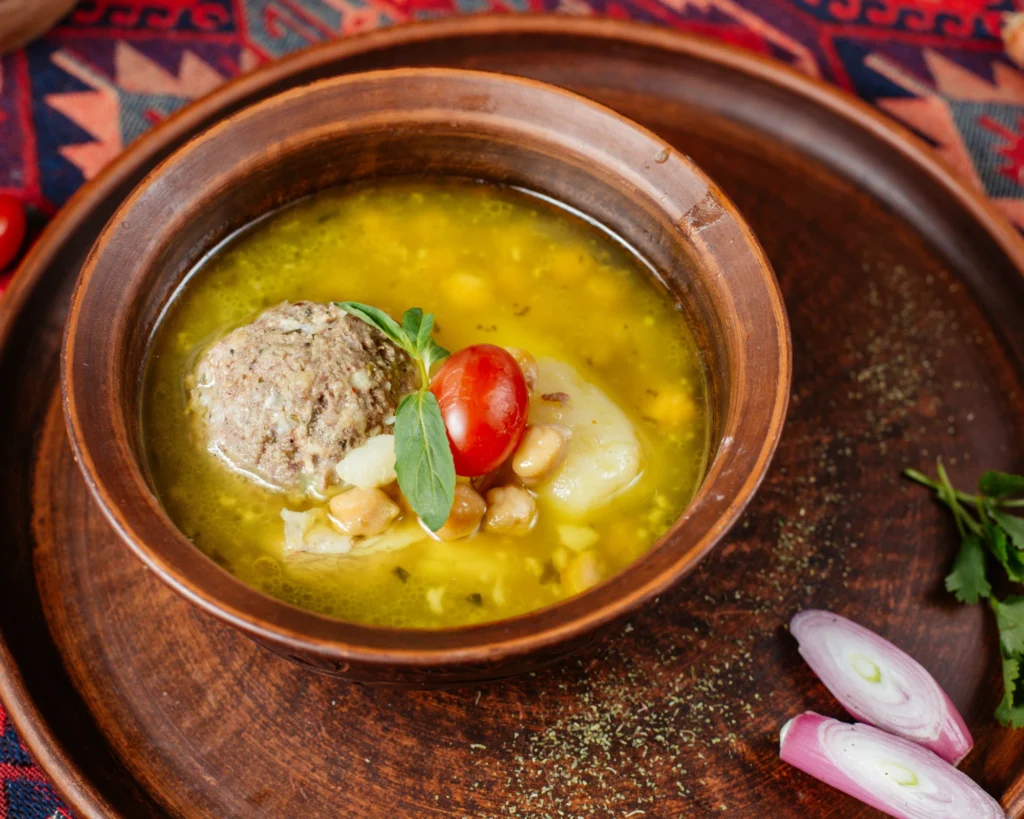
The Role of Food in Colombian Celebrations
Colombian foods play a central role in festivities and celebrations throughout the year. Here’s how different dishes connect to various celebrations:
Christmas and New Year
- Natilla (custard dessert)
- Buñuelos (cheese fritters)
- Lechona (stuffed pork)
- Ajiaco (special holiday preparation)
Carnival Season
- Street food takes center stage
- Regional specialties become more prominent
- Special festival-only dishes appear
Family Gatherings
- Sancocho as the centerpiece
- Multiple types of arepas
- Variety of Colombian dishes served family-style
Modern Interpretations of Colombian Cuisine
Contemporary chefs are reimagining Colombian traditional food while maintaining its essence:
Fusion Trends
- Arepa burgers
- Gourmet empanadas with non-traditional fillings
- Modern takes on traditional soups
- International ingredients in Colombian preparations
Health-Conscious Adaptations
- Baked instead of fried empanadas
- Lighter versions of traditional stews
- Vegetable-forward interpretations of classic dishes
Cooking Methods in Colombian Cuisine
Understanding the cooking methods helps appreciate Colombian foods better:
Traditional Techniques
- Slow Cooking
- Used for beans, soups, and stews
- Develops deep, complex flavors
- Grilling (Asado)
- Popular for meats and corn
- Adds smoky flavor to dishes
- Frying
- Essential for empanadas and buñuelos
- Creates characteristic textures
- Steaming
- Used for tamales
- Preserves nutrients and flavors
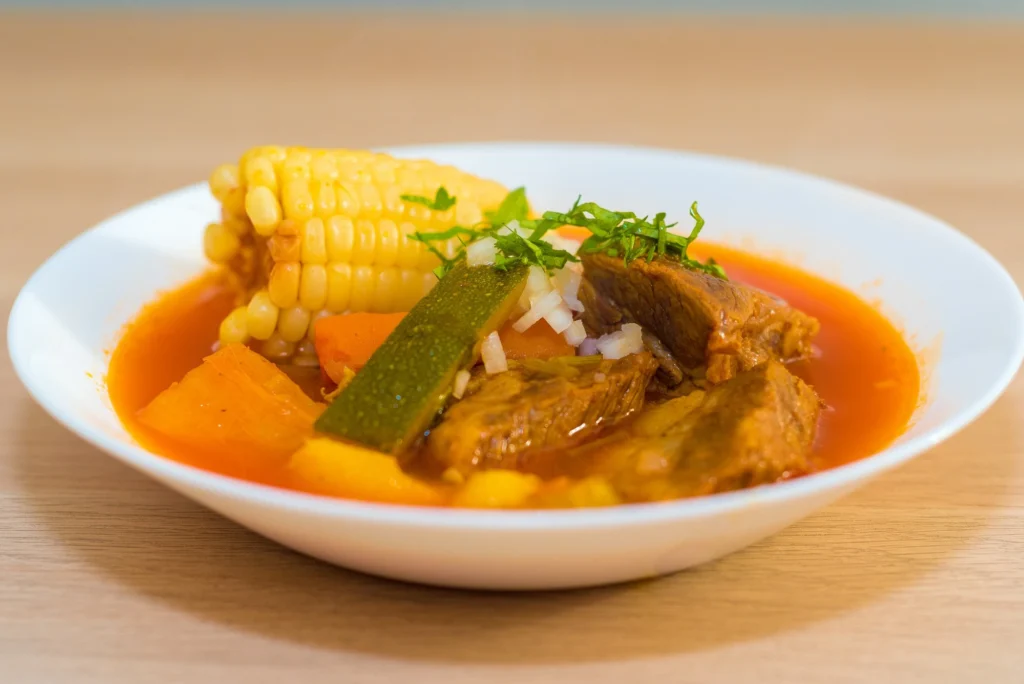
Shopping Guide for Colombian Ingredients
For those wanting to recreate Colombian dishes at home:
Essential Pantry Items
- Masarepa (special corn flour for arepas)
- Panela (unrefined whole cane sugar)
- Guascas (herb for Ajiaco)
- Colombian chocolate
- Various beans
Fresh Ingredients
- Plantains (both green and ripe)
- Yuca root
- Colombian peppers
- Various potatoes
- Fresh herbs and spices
Food Etiquette in Colombia
Understanding food customs enhances the Colombian dining experience:
Dining Customs
- Lunch is the main meal
- Soup is often served first
- Coffee is offered throughout the day
- Meals are social events
Table Manners
- Wait for the host to start
- Use utensils continental style
- Keep hands visible on the table
- Express appreciation for the food
Health Benefits of Colombian Foods
Many traditional Colombian dishes offer significant nutritional benefits:
Nutritional Highlights
- Bean-based dishes: High in protein and fiber
- Tropical fruits: Rich in vitamins and antioxidants
- Soups: Hydrating and nutrient-dense
- Fresh ingredients: Minimal processing
Balanced Meal Components
- Protein sources: Varied and abundant
- Complex carbohydrates: Energy-sustaining
- Healthy fats: From avocados and fish
- Vegetables: Diverse and seasonal
Tips for First-Time Tasters
For those new to Colombian cuisine:
Starting Points
- Begin with milder dishes like arepas
- Try different regional specialties
- Explore street food options
- Sample various tropical fruits
Food Safety
- Choose reputable restaurants
- Be cautious with street food
- Drink bottled water
- Ask locals for recommendations
Preserving Colombian Culinary Heritage
The preservation of Colombian traditional food is crucial for cultural identity:
Educational Initiatives
- Cooking schools
- Cultural programs
- Food festivals
- Recipe documentation
Modern Challenges
- Globalization impact
- Preserving authentic techniques
- Passing down family recipes
- Maintaining traditional ingredients
Share your experiences with Colombian dishes in the comments below, and don’t forget to subscribe for more culinary adventures!
Frequently Asked Questions About Colombian Food
1. What are the most popular Colombian dishes?
Colombian foods include numerous beloved dishes that have become cultural icons. The most popular ones include:
- Bandeja Paisa: The ultimate Colombian comfort food platter
- Arepas: Versatile cornmeal patties eaten throughout the day
- Ajiaco: A hearty soup from the Bogotá region
- Empanadas: Golden-fried corn pastries with various fillings
- Sancocho: A rich, traditional soup perfect for family gatherings These dishes represent just a small sample of Colombia’s rich culinary heritage, with each region offering its own specialties and variations.
2. What ingredients are commonly used in Colombian cuisine?
Colombian traditional food relies on a diverse array of ingredients that reflect the country’s biodiversity:
- Starches: Potatoes (including unique varieties like papa criolla), yuca (cassava), and corn
- Proteins: Beef, pork, chicken, and various types of seafood in coastal regions
- Vegetables: Plantains (both green and ripe), avocados, tomatoes, and onions
- Legumes: Various types of beans, especially red beans (frijoles)
- Fruits: An incredible variety of tropical fruits including lulo, guanábana, maracuyá, and mora
- Herbs and Spices: Cilantro, guascas (essential for Ajiaco), cumin, and Colombian peppers
3. Is Colombian food spicy?
Unlike some other Latin American cuisines, Colombian dishes typically focus on rich, savory flavors rather than heat. While Colombian foods aren’t generally spicy, they’re incredibly flavorful thanks to:
- Careful seasoning with herbs and spices
- Slow-cooking methods that develop deep flavors
- The use of hogao (a traditional sauce base)
- Regional variations in preparation methods Spicy ají sauce is usually served on the side, allowing diners to adjust the heat level to their preference.
4. What is Bandeja Paisa?
Bandeja Paisa is the national dish of Colombia and a prime example of Colombian traditional food. This hearty platter includes:
- Red beans cooked with pork
- White rice
- Ground beef (usually seasoned and grilled)
- Chicharrón (crispy pork belly)
- Fried egg (typically sunny-side up)
- Ripe plantains
- Avocado
- Arepa Originally from the Antioquia region, this dish reflects the hardy meals needed by workers in the coffee-growing regions.
5. Are there vegetarian options in Colombian cuisine?
Yes, while Colombian foods are often meat-centric, there are numerous delicious vegetarian options:
- Cheese-filled arepas
- Bean-based dishes (without meat)
- Vegetable soups
- Patacones (fried plantains)
- Rice and vegetable combinations
- Fresh fruit juices and smoothies Many traditional dishes can also be adapted to vegetarian preferences while maintaining their authentic flavors.
6. What is the significance of Arepas in Colombian culture?
Arepas are more than just food in Colombia; they’re a cultural symbol that represents:
- Daily sustenance and tradition
- Family gatherings and shared meals
- Regional identity (different regions have their own styles)
- Cultural heritage dating back to pre-Columbian times Found at every meal, arepas are one of the most versatile Colombian dishes, serving as both a staple food and a canvas for countless variations.
7. What types of street food can I find in Colombia?
Colombian street food offers a delicious window into local cuisine:
- Empanadas: Filled with meat, chicken, or cheese
- Buñuelos: Cheese fritters popular during holidays
- Arepas de Huevo: Stuffed with egg and meat
- Patacones: Fried plantain discs
- Perros Calientes: Colombian-style hot dogs
- Chorizo with Arepa: A popular street snack
- Obleas: Thin wafers with arequipe (dulce de leche)
8. How does Colombian cuisine vary by region?
The food of Colombia is incredibly diverse, with distinct regional characteristics:
- Caribbean Coast: Seafood, coconut-based dishes, and tropical influences
- Andean Region: Hearty soups, potato dishes, and meat-based meals
- Pacific Coast: Unique seafood preparations with African influences
- Amazon Region: Exotic fruits and freshwater fish
- Eastern Plains: Meat-heavy dishes and unique cooking methods Each region’s cuisine is shaped by its climate, available ingredients, and cultural influences.
9. What desserts are popular in Colombia?
Colombian desserts reflect the country’s love for sweet treats:
- Arequipe (dulce de leche): A creamy caramel spread
- Bocadillo (guava paste): Often served with cheese
- Natilla: A custard-like dessert popular during Christmas
- Tres Leches Cake: A sponge cake soaked in three types of milk
- Flan: A creamy caramel custard
- Brevas con Arequipe: Figs with caramel sauce Many desserts incorporate tropical fruits and traditional preparation methods.
10. Can I find Colombian food outside of Colombia?
Yes, Colombian dishes are becoming increasingly available worldwide:
- Major cities often have Colombian restaurants
- Specialty grocery stores stock Colombian ingredients
- Food trucks and festivals feature Colombian cuisine
- Online retailers ship Colombian products internationally
- Colombian cookbooks and recipes are widely available However, for the most authentic experience, nothing beats trying these dishes in Colombia itself, where you can experience the full cultural context of the cuisine.
Conclusion
Colombian foods represent more than just sustenance – they’re a celebration of culture, history, and community. Whether you’re planning a trip to Colombia or looking to explore these flavors in your own kitchen, the diverse world of Colombian dishes offers something for every palate. From the hearty Bandeja Paisa to the comforting Ajiaco, each dish tells a story of tradition, innovation, and love for good food.
Remember, the best way to experience Colombian traditional food is to dive in with an open mind and an empty stomach. ¡Buen provecho!

